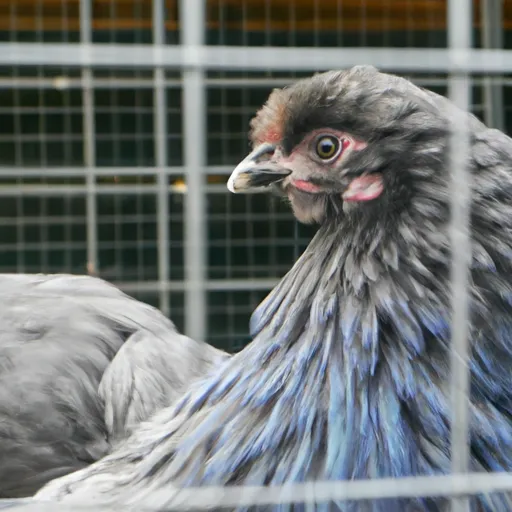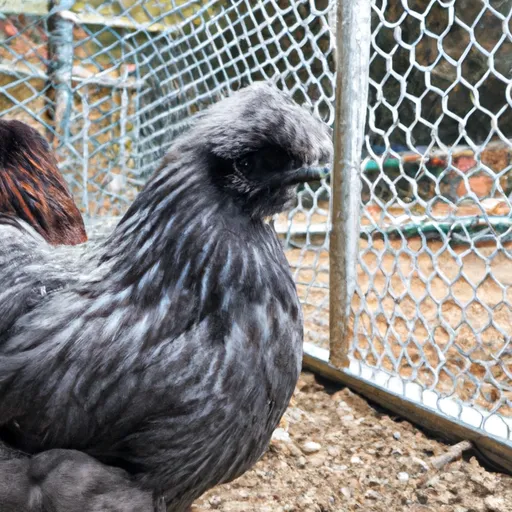What Color eggs do Blue Ameraucana Chickens lay?
While Blue Ameraucana chickens are known for consistently laying blue eggs, the actual color of the eggs can be influenced by several factors.
Genetics
Genetics play a significant role in determining the color of eggs laid by Blue Ameraucana chickens.
The blue coloration is a dominant trait in this breed, meaning that if a bird inherits the blue gene from one parent, it will exhibit the blue feather color and lay blue eggs.
However, if a bird inherits the blue gene from both parents, it may exhibit a more intense blue coloration.
Environment
The environment in which Blue Ameraucanas are raised can also impact the intensity of the blue color in their eggs.
Factors such as temperature, sunlight exposure, and overall stress levels can slightly affect the eggshell color. While these environmental factors may not drastically alter the blue color, they can contribute to subtle variations in shade.
Diet
Another factor that can influence the eggshell color of Blue Ameraucana chickens is their diet. The nutrients present in their feed can influence the pigmentation process.

For example, a diet rich in certain pigments, such as those found in marigold petals or dark leafy greens, may enhance the intensity of the blue color.
However, it's important to note that diet alone cannot change the eggshell color from blue to another color, as the genetics of the breed determine this characteristic.
Hatching and Brooding Blue Ameraucana Eggs
Incubation
To hatch Blue Ameraucana eggs, an incubator is commonly used.
The eggs should be collected regularly and stored in a cool, dry place to maintain their viability until they are ready for incubation.
The ideal temperature for incubating Blue Ameraucana eggs is around 99-100°F (37-38°C), with a humidity level of approximately 50-60%. It's essential to monitor these factors closely to ensure successful hatch rates.
The incubation period for Blue Ameraucana eggs is approximately 21 days. During this period, the eggs require regular turning to prevent the embryo from sticking to the shell and to facilitate proper development.
It is recommended to turn the eggs at least three times a day. On the 18th day, the eggs should be placed in a separate hatching tray, also known as a "lockdown" phase, to minimize movement and create a stable hatching environment.
Brooding
Once the Blue Ameraucana chicks hatch, they need a warm and safe brooding area to thrive.
A brooder box or a sectioned-off area within the coop is ideal for this purpose.
The temperature inside the brooder should be maintained at around 95°F (35°C) initially and gradually decreased by 5°F (2.8°C) each week until they are fully feathered and can regulate their body temperature.
A clean and comfortable bedding material, such as wood shavings or straw, should be provided to keep the chicks warm, absorb moisture, and allow for easy cleaning.
Additionally, a consistent supply of fresh water and a balanced chick starter feed suitable for their age should be available at all times.
Blue Ameraucanas as Layers
Egg Production
Blue Ameraucanas are considered moderate layers, capable of producing around 200-250 eggs per year on average. However, it's important to note that egg production can vary depending on individual birds, genetics, and environmental factors.
While they may not be the most prolific layers, their unique blue eggs and other desirable characteristics make up for the slightly lower egg production compared to other breeds.
Size
Blue Ameraucana eggs are typically medium-sized, similar to that of most standard chicken breeds.
They have a slightly smaller size compared to breeds specifically bred for large egg production. However, the size variation among hens within the breed can exist, as with any chicken breed.
Quality
The quality of Blue Ameraucana eggs is highly regarded by egg enthusiasts and culinary enthusiasts alike.
These eggs have a reputation for having rich and flavorful yolks, making them an excellent choice for cooking and baking.
The unique blue color of the shells adds an aesthetically pleasing touch to any egg-based dish, making them a favorite among those who appreciate culinary innovation.
Benefits of Raising Blue Ameraucana Chickens
Unique Egg Color
One of the significant benefits of raising Blue Ameraucana chickens is the joy and novelty of collecting and showcasing their beautiful blue eggs.
The unique blue color of these eggs can spark conversations and impress guests. If you enjoy sharing eggs with friends or selling them at local markets, Blue Ameraucana eggs can be a unique selling point and evoke curiosity.
Hardiness
Blue Ameraucanas are known for their hardiness and adaptability to various climates.
They can withstand both cold and hot temperatures, making them suitable for different regions. Their robust nature and ability to forage help them thrive in free-range environments.
Dual-Purpose
Aside from their striking appearance and egg-laying capabilities, Blue Ameraucanas are considered a dual-purpose breed.
This means that they are suitable for both egg production and meat. While they may not be as meaty as some specialized meat breeds, the Blue Ameraucana's moderate size and flavorful meat make them a viable option for those looking to raise chickens for both eggs and meat.
Challenges in Raising Blue Ameraucana Chickens
Availability
One of the challenges in raising Blue Ameraucana chickens is their availability.
Blue Ameraucanas are relatively rare compared to other chicken breeds, making it more challenging to find a reliable source for purchasing or hatching eggs.
Due to their desirability, demand often exceeds supply, and waiting lists may be common when trying to obtain these chickens.
Special Care
Blue Ameraucanas, like any other breed, require proper care and attention to ensure their well-being.
While they are generally hardy birds, it's essential to provide them with appropriate shelter, a well-balanced diet, and regular health checks.
Also, their crests and muffs require occasional grooming to prevent debris from accumulating and causing discomfort or other health issues.
Breeding Challenges
Maintaining the blue egg color in Blue Ameraucanas can be a challenge during the breeding process.
The blue gene is responsible for the blue feather color and eggshell color can sometimes be diluted or altered if bred with other chicken breeds that carry different color genes.
Therefore, breeders must carefully select breeding stock to preserve and enhance the desired blue characteristics.
Caring for Blue Ameraucana Chickens
Housing
Blue Ameraucana chickens require suitable housing to ensure their safety and comfort.
The coop should provide protection against predators, extreme weather conditions, and sufficient space for the birds to move around comfortably.
Adequate ventilation is crucial to maintain good air quality, and the coop should be cleaned regularly to prevent the buildup of waste and parasites. Additionally, nesting boxes should be provided for the hens to lay their eggs and feel secure.
Feed and Nutrition
Proper nutrition is essential for the health and productivity of Blue Ameraucana chickens.

A balanced commercial chicken feed formulated specifically for laying hens is recommended.
The feed should contain essential nutrients such as protein, carbohydrates, vitamins, and minerals. Additionally, offering occasional treats such as fruits, vegetables, and scratch grains can provide enrichment and variety in their diet.
Fresh, clean water should always be available for the chickens to stay hydrated.
Healthcare
Routine healthcare plays a vital role in maintaining the well-being of Blue Ameraucana chickens.
Regular health checks should be conducted to monitor their overall health, physical condition, and to detect any signs of illness or parasites.
Vaccinations, parasite control, and appropriate veterinary care should be provided based on the specific needs of the flock.
Good biosecurity practices, such as maintaining cleanliness and preventing contact with potentially infected birds, will help reduce the risk of diseases spreading.
Breeding Blue Ameraucana Chickens
Selecting Breeding Stock
Breeding Blue Ameraucana chickens requires careful selection of breeding stock to ensure the desired traits, including the blue feather color and eggshell color, are preserved and enhanced.
Birds with the correct traits should be chosen based on their physical appearance, temperament, and genetic background. It's important to avoid breeding individuals with any health issues or genetic faults to maintain the overall health and vitality of the breed.
Maintaining Egg Color
To maintain the blue egg color in subsequent generations, it's crucial to select and breed Blue Ameraucana chickens with consistently blue egg-laying tendencies.
Breeding birds that consistently produce eggs with intense blue coloration will increase the chances of offspring inheriting the same trait.
Regular monitoring of egg color and culling of birds that do not meet the desired standards will help ensure the quality of the breed.
Hatching Blue Chicks
When breeding Blue Ameraucana chickens, it's important to note that the blue feather color and blue eggshell color are not necessarily linked.
While most Blue Ameraucanas will lay blue eggs, not all blue egg layers will exhibit the typical blue feather color. Therefore, careful observation of both feather and egg colors is necessary when selecting breeding pairs.
Tips for Raising Blue Ameraucana Chickens
Providing Enrichment
Blue Ameraucana chickens, like all chickens, benefit from environmental enrichment.

Providing various forms of entertainment, such as perches, dust-bathing areas, and foraging opportunities, keeps them mentally stimulated and prevents boredom.
Scatter treats or provide feed in interactive feeders to encourage natural foraging behavior.
Socializing Chickens
Blue Ameraucanas thrive when they have opportunities to socialize. Spending time with your chickens, offering treats by hand, and gentle handling can help build trust and foster a positive bond with them.
Socializing chickens also minimizes their stress levels, making them more amiable and easier to manage.
Protecting from Predators
Predators pose a constant threat to backyard chickens, including Blue Ameraucanas. Ensuring their safety is crucial through the implementation of predator-proof fencing, secure coop design, and regular visual checks for signs of predators in the area.
Securing the coop at night and providing adequate lighting can help deter nocturnal predators.
In conclusion, Blue Ameraucana chickens are a unique and fascinating breed that adds a touch of beauty and novelty to any backyard flock.
Their striking blue feather color, coupled with their calm temperament and colored eggs, makes them a popular choice for chicken enthusiasts. With proper care, housing, and nutrition, Blue Ameraucanas can provide both enjoyment and a steady supply of delicious blue eggs.
Whether you are attracted to their eye-catching appearance or their dual-purpose nature, Blue Ameraucanas are sure to be a delightful addition to any chicken-raising adventure.
